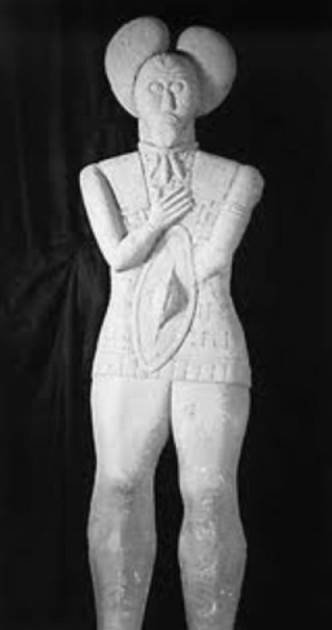Roquepertuse, municipality of Velaux (Bouches du Rhône)
The plateau of Roquepertuse, on Velaux municipal land overlooks the Arc Valley, a short distance away from the Étang de Berre. The site is known thanks first to 19th century excavations which unearthed two statues of « squatting warriors »
, and to Henri de Gérin-Ricard's work, which brought to light between 1917 and 1927 the remains of statues (among which those of the two-headed Hermes and of the vulture) and infrastructures belonging to a portico with skull shaped niches. At the time it got labelled as a Liguro-Celtic sanctuary. Recent research clarifies that the first actual land occupation goes back to the 5th century BC. Between the end of the 4th and the beginning of the 2nd century, the place would know five waves of settlement. The site was destroyed by fire during a siege in the second half of the 3rd century.
The edifice built circa 300 BC is set astride terraces 1 to 5 and covers a 17.50m by roughly 3.50m rectangle. The ground floor is not intended as an ambulatory since a 1.20 m or so gap stands empty of any structure between the pillars and the far retaining wall. The spacing between pillars is not regular. The only reconstructed lintel remains uncompleted. The way the two floors communicated is not know. The pillars and lintels exhibit cavities intended for the display of human skulls, some of which were retrieved alongside the architectural remains. The “Hermes[1]” was discovered on Terrace 1 and must belong with the portico. It is difficult to establish the exact role of this portico. Supposing the skulls to be those of defeated warriors one may envisage the site as a trophy. Should they, on the other hand, be ancestors' remains, the portico could be understood as honouring community life or that of an aristocratic elite.

The statues (ten or more) were damaged in the course of the 3rd century BC. Owing to the concept of « hellenization »
, and to the fact that no archaic or classical sculptures had been discovered in Western Mediterranean Greek cities, historians long held that the « squatting warriors »
statues dated to the 2nd or 1st century BC. However, with the discovery of the statue from Glauberg in Hesse, Germany, which dates back to the end of 6th or the 5th century BC, the study of South-European statuary has been reviewed. A stylistic analysis, the presence of cuirasses with large backplates, the “mistletoe leaf” headdress apparently sported by the « Hermes »
, the traces of a painted geometric decoration rather point to the 5th century BC. The questions about archaeological context in which these statues have been set up remain unanswered. Is it feasible that they were displayed in the 5th century when the village was loosely configured and unwalled? Or, alternatively, were the statues moved around following the movements of existing elites? Equally open to debate is their meaning. The fact that they concern warriors exclusively loads these statues with political implication – which does not exclude their endowment with religious attributes besides.
Recent excavations have thus brought out the distinction between on the one hand a 1300 square meters era closed off by a defence wall sometime in the 3rd century BC the monuments of which would have been built at that time, and, on the other hand, the rest of the settlement dedicated to housing on some three and a half acres of land.







